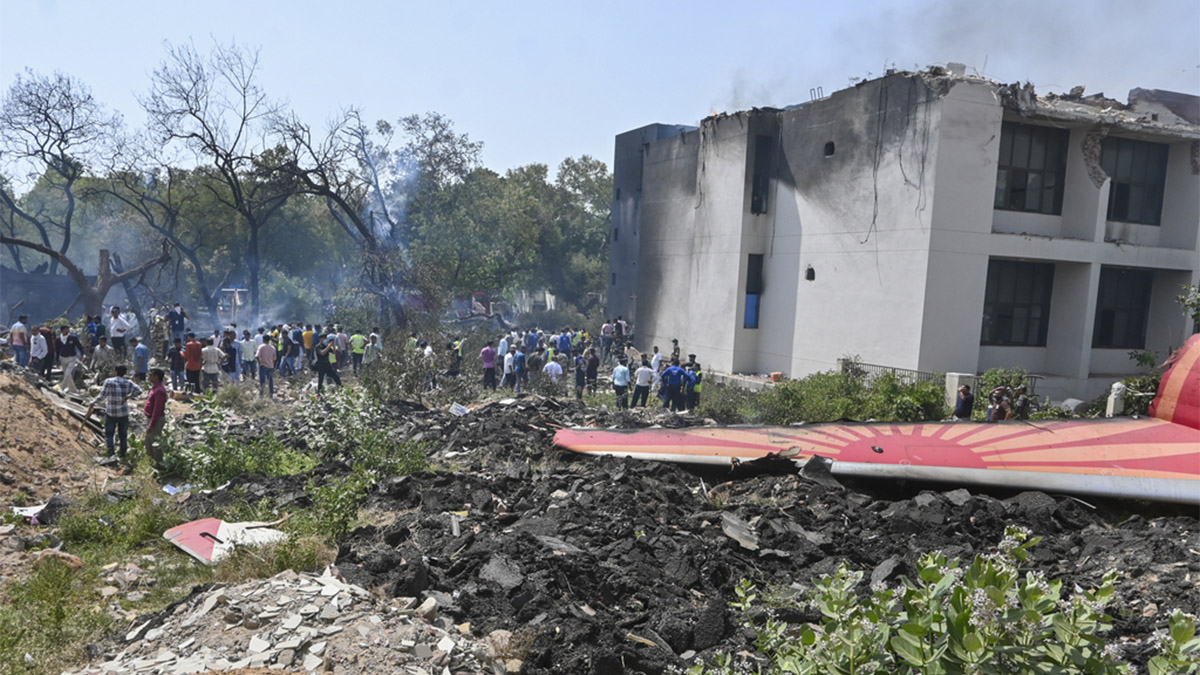The tragic crash of Air India Flight AI 171 —a Boeing 787 Dreamliner —shortly after takeoff from Ahmedabad’s Sardar Vallabhbhai Patel International Airport has cast a long shadow over civil aviation sector and urban safety planning.
With over 240 people on board, the aircraft was bound for London when it plunged into Meghaninagar, a densely populated neighbourhood located just a few kilometres from the airport. Within minutes of takeoff, the jetliner’s descent sparked an enormous blaze, consuming residential structures and leaving scores of residents injured.
This harrowing event has reignited a complex, often overlooked issue: the proximity of high-density residential areas to major international airports. While aviation safety has seen substantial advancements over the decades, the tragedy in Ahmedabad underlines how urban planning lapses and insufficient zoning regulations can render those advances impotent in moments of crisis.
Vulnerability at low altitudes
Air travel is statistically among the safest modes of transportation, but certain phases of flight are more vulnerable than others. Takeoff and landing—when aircraft are at low altitudes and manoeuvering at relatively slow speeds—pose significant risks. During these phases, pilots have limited time and restricted spatial margins to respond to mechanical failures, bird strikes or other emergencies.
In the case of Flight AI 171, it appears the aircraft had barely cleared the airport perimeter before encountering trouble. With insufficient altitude to manoeuver or regain control, the aircraft descended rapidly into Meghaninagar, giving the crew no feasible options to divert away from the populated area. The tragic consequences reflect the intrinsic hazards posed when residential zones are permitted to develop within close range of an airport’s flight corridor.
Urban encroachment into flight paths
The Meghaninagar incident illustrates a growing global issue: the expansion of urban settlements into flight paths and airport buffer zones. Ahmedabad’s situation is far from unique.
As urban populations swell and cities sprawl outward, land use planning often fails to keep pace. Zoning enforcement around airports—typically intended to preserve safe airspace—can lapse under different form of pressures, giving way to haphazard construction.
Impact Shorts
More ShortsThe consequence is predictable and perilous. With structures directly underneath flight paths, any in-flight emergency transforms into a multi-layered disaster affecting both those on board and those on the ground.
The firestorm factor
The extent of destruction caused by today’s crash was exacerbated by the aircraft’s heavy fuel load. As a long-haul international flight bound for London, the Boeing 787 would have carried tens of thousands of litres of aviation fuel at the time of departure. This immense fuel volume significantly increased the severity of the post-crash fire.
In urban aviation incidents, fuel acts not only as a fire accelerant but also broadens the radius of destruction. Flammable materials in nearby buildings, narrow roads restricting emergency access and densely packed structures all compound the difficulty for first responders.
In Meghaninagar, the fire spread quickly through adjoining homes, making the response even more challenging for firefighting and medical teams.
Historical echoes
Tragic as it is, the crash of Flight AI 171 joins a troubling list of similar incidents from across the world. The aviation community has witnessed numerous such events where aircraft crashes have been amplified by the presence of nearby residential or commercial zones.
In May 2025, a Cessna Citation II aircraft crashed into San Diego’s Murphy Canyon neighbourhood during final approach, igniting fires and causing extensive property damage. In 1992, El Al Flight 1862—a cargo aircraft—crashed into a residential apartment block in Amsterdam’s Bijlmermeer district after losing two engines shortly after takeoff, killing 43 individuals. A decade later, a small aircraft crashed into Milan’s Pirelli Tower, sparking intense public debate about the role of inner-city airports.
Each of these tragedies shares a common denominator: inadequate spatial buffers between airports and urban populations. Despite their devastating outcomes and the investigations that followed, similar risks persist in cities around the world, including in India’s rapidly urbanising metros.
The case of the upcoming Navi Mumbai airport
While tragedy unfolded in Ahmedabad, developments in India’s airport infrastructure spotlight both promise and delay. The Navi Mumbai International Airport, which was initially expected to commence operations by mid-May 2025, remains under construction. The Airports Authority of India (AAI) recently issued a Notam (Notice to Airmen) declaring the aerodrome unavailable until August 6, indicating continued delays in its commissioning.
The Aeronautical Information Publication (AIP) issued earlier this year had omitted key navigational details, such as departure and arrival routes, though it included vital information on airport infrastructure, firefighting readiness, obstacle listings and fuel capacities. The AIP’s listing of 225 surrounding obstacles—including 86 residential buildings and cell masts—raises early warnings about the encroachment risks that Navi Mumbai could soon face if zoning enforcement is not proactive.
Meanwhile, the Noida International Airport, another ambitious project, is progressing toward operational readiness. Notably enough, this satellite city of Delhi is immersed in high rises as well. Like Navi Mumbai, this airport must remain vigilant about buffer zones and urban development. With an anticipated capacity of 12 million passengers in its initial phase—and 70 million annually upon full expansion—the surrounding ecosystem must be managed to avoid replicating risks evident in older urban-airport environments.
Governance and community safety
The crash in Ahmedabad is not merely an aviation incident. It is a wake-up call for stricter enforcement of zoning laws, compulsory resettlement of high-risk residential pockets and the creation of adequate green buffer zones should be prioritised. Advanced warning systems, better community education about aviation risks and strategic emergency planning can also mitigate potential damage in case of future incidents.
Learning from tragedy, planning for safety
The Air India crash in Ahmedabad is a stark and painful reminder of the real-world consequences of ignoring urban planning in the context of aviation safety. It highlights the complex interplay between infrastructure, regulatory foresight and the lived realities of citizens residing under flight paths.
The lessons from Meghaninagar must not be shelved as another tragic chapter in aviation history. They must catalyse reform, enforce accountability and drive a systemic rethinking of how airports and cities coexist.
)